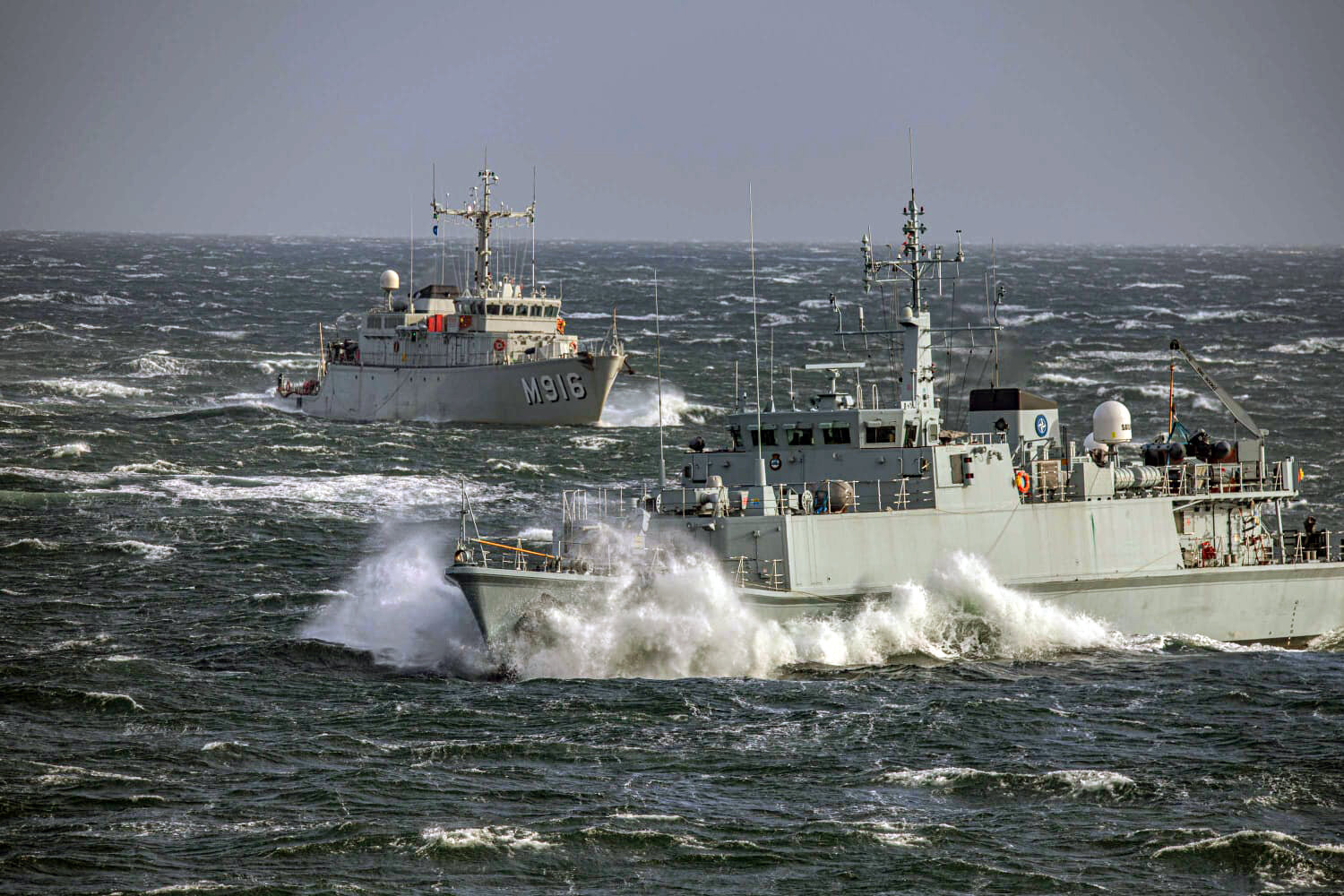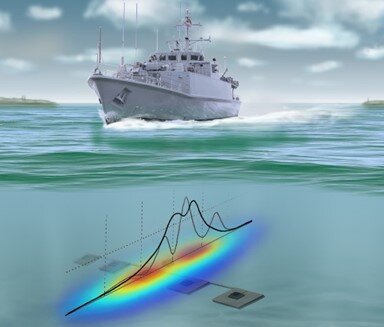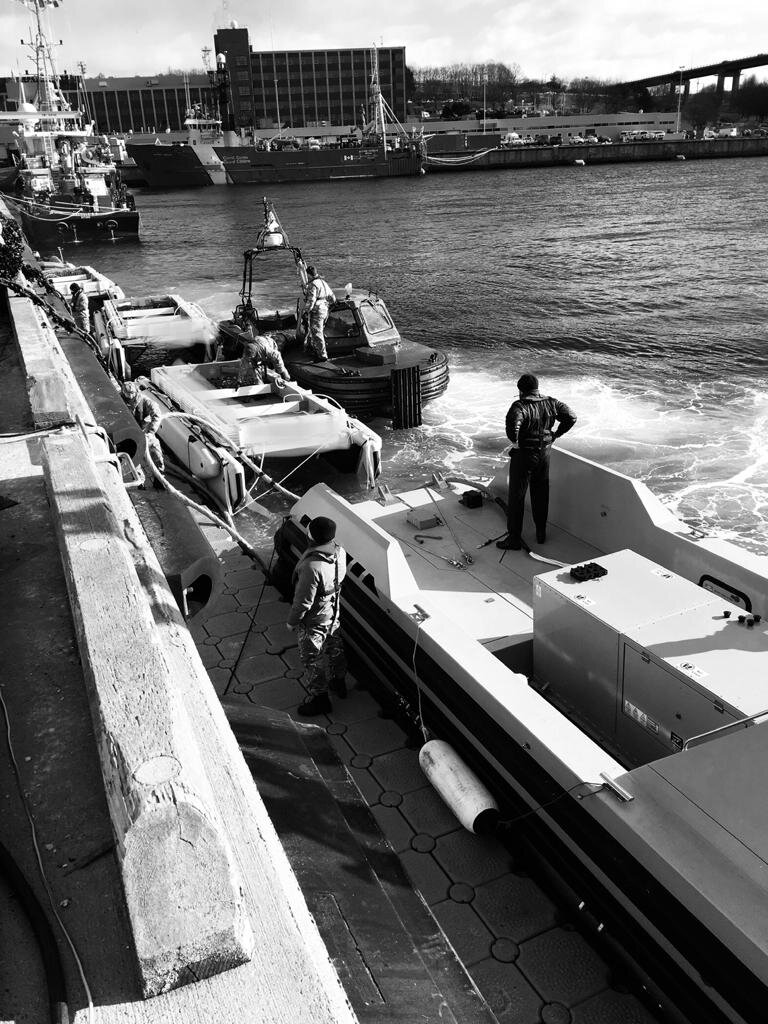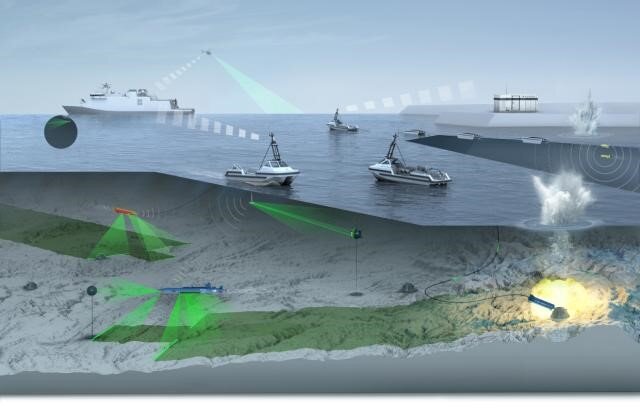ROYAL NAVY
MINE WARFARE & DIVING 2025
RN Minewarfare & Diving news and history from PROJECT VERNON
THE ROYAL NAVY MINE COUNTERMEASURES FLOTILLA
For the latest news from the Royal Navy’s Mine Countermeasures Flotilla, Ships and Crews click on the links below:
Mine Threat & Exploitation Group (MTXG)
MTXG comprises: X-Ray Squadron Units 1 & 2 (Expeditionary); Yankee Sqn Unit 1 (Expeditionary) and Unit 2 (ex-MASTT); and Zulu Sqn Unit 1 (Clyde-based Homeland).
More about Mission System Team One in the Mine Threat Exploitation Group here.
More about the RNs Autonomous MCM Systems here.
More about modern minesweeping here.
2nD MCM Squadron
HM HUNT Class Ships BROCKLESBY, CATTISTOCK, CHIDDINGFOLD, HURWORTH, LEDBURY, MIDDLETON and the SANDOWN Class Mine Hunter HM Ships BANGOR, based at HM Naval Base PORTSMOUTH
HMS CHIDDINGFOLD
HMS BROCKLESBY
HMS CATTISTOCK
HMS CHIDDINGFOLD
HMS HURWORTH
HMS LEDBURY
HMS MIDDLETON
Details X ex Twitter
A SUMMARY OF RECENT OPERATIONS
by Rob Hoole
Second MCM Squadron
The Portsmouth-based Second MCM Squadron (now the only MCM squadron) comprises the Hunt class minehunters BROCKLESBY (Crew 2), CATTISTOCK (Crew 5), CHIDDINGFOLD (Crew 6), HURWORTH (Crew 4), LEDBURY (Crew 1) and MIDDLETON (Crew 7) plus the Sandown class minehunters BANGOR (Crew 9) and PEMBROKE (CC).
MIDDLETON is deployed in the Gulf, based at the NSF (Naval Support Facility) at Mina Salman in Bahrain for Operation KIPION MCM, together with MTXG units, under the Command of COMUKMCMFOR (Commander UK MCM Force).
BANGOR is believed to remain in dry dock in Bahrain following her collision damage. She is due to be decommissioned this year and will not be returned to operations in the Gulf.
CATTISTOCK was visited by General Sir Gwyn Jenkins RM, the First Sea Lord & Chief of the Naval Staff, in early August.
HURWORTH exercised with fellow Hunts LEDBURY and CATTISTOCK in the Clyde areas in early July. She entered dry dock at Falmouth for maintenance on 16 July after a ‘Hands to Bathe’ in Cornish waters. The dock was flooded up again on 30 July and she left Falmouth on 7 August, arriving in Portsmouth the following day.
LEDBURY visited Cardiff in late June. Early July saw Crew 3 relieved by Crew 1. During Crew 3’s tenure, the ship had steamed 4,641 nm and conducted over 100 Seafox missions, 78 diving serials (564 minutes underwater), 31 pilotages and over 300 nm of REMUS operations with MTXG. She was spotted on Loch Long on 28 July.
MIDDLETON has published several photos of her culinary offerings and photos showing the angling prowess of PO Mike Tysoe, one of her Marine Engineers. She reported conducting MCM and diving training, accompanied by a school of dolphins, in the Gulf in early August.
Several photos were published online showing the decommissioned BRECON, the first Hunt-class MHSC built, at her mooring off Torpoint in Plymouth as HMS RALEIGH’s training ship.
PEMBROKE has been handed over to the Romanian Navy and renamed CAPITAN CONSTANTIN DUMITRESCU. She will join the former BLYTH, now renamed SUBLOCOTENENT ION GHICULESCU, in the Black Sea.
MTXG – Mine & Threat Exploitation Group
MTXG comprises: X-Ray Squadron Units 1 & 2 (Expeditionary); Yankee Sqn Units 1 & 2 (Expeditionary); and Zulu Sqn Unit 1 (Clyde-based Homeland).
WO(MW) Simon Oldroyd was formally presented with his Warrant Parchment in early August by Captain Simon Pressdee, (Capt PUXD Patrol, Underwater Exploitation & Diving).
In late July, members of MTXG’s HQ staff undertook Adventurous Training that included climbing Ben Lawers in Glencoe.
See the ‘Latest News’ page of the MCD Officers’ Association’s website here or Project Vernon’s Facebook page here for more recent updates and photos.
MCM OPERATIONS IN THE MIDDLE EAST
Commander UK Mine Countermeasures Force
MIDDLETON and BANGOR are deployed in the Gulf, based at the NSF (Naval Support Facility) at Mina Salman in Bahrain for Operation KIPION MCM, together with MTXG units, under the Command of COMUKMCMFOR (Commander UK MCM Force).
MIDDLETON visited Abu Dhabi for the International Defence Exhibition and Naval Defence and Maritime Security Exhibition and some of her ship’s company were able to attend the Bahrain Grand Prix in April thanks to ‘Tickets for Troops’.
BANGOR is in dry dock following her collision damage. She is due to be decommissioned this year and will not be returned to operations in Bahrain.
Components of the MTXG are also operating in the Gulf.
UKRAINIAN AND ROMANIAN NAVY SHIPS
The Ukrainian UKS CHERNIHIV (ex-HMS GRIMSBY) and UKS CHERKASY (ex-HMS SHOREHAM) have moved base from Scotland to Portsmouth. They will not be permitted to enter the Black Sea until the end of the conflict with Russia. In the meantime, Turkey, Bulgaria and Romania have agreed to work together to clear the Black Sea of Russian-laid mines. The Romanian Navy includes ROS SUBLOCOTENENT ION GHICULESCU (exHMS BLYTH) and ROS CAPITAN CONSTANTIN DUMITRESCU (ex-HMS PEMBROKE).
ROYAL NAVY DIVING
Royal Navy divers carry out diving and explosive ordnance disposal operations. The RN’s Diving and Threat Exploitation Groups are made up of Squadrons ALPHA, BRAVO, DELTA and ECHO which are based at HM Naval Bases Clyde, Plymouth and Portsmouth.
More about Royal Navy Diving and Threat Exploitation Groups:
Diving and Threat Exploitation Groups on X (ex Twitter)
NATO OPERATIONS
HMS GRIMSBY in company with BNS BELLIS clears eighteen WWII bombs off Oslo – February 2020. Image credit: NATO
Standing NATO MCM Group 1on Facebook
Standing NATO MCM Group 2 on Facebook
The Future of Royal Navy MCM
The Mine Threat Exploitation Group (MTXG)
The Marine Autonomous Trials Team (MASTT)
MORE MINE WARFARE AND DIVING NEWS:
The Mine Warfare and Diving (MAD) Magazine 2023 - here
The Mine Warfare and Diving Monument - Project Vernon
The Mine Warfare Association
Details X
The MCD Officers Association - website.
For other recent history and up to date developments check out the Mine Warfare and Diving Magazine here.
The latest news from the Royal Navy
and the Royal Navy on Twitter
PRE 2025
THE MARITIME AUTONOMOUS SYSTEMS TRIALS TEAM (MASTT) - THE FUTURE OF ROYAL NAVY MCM
On 3 Nov, MASTT was presented with the Outstanding MW Team of the Year Award at the inaugural Mine Warfare Annual Dinner & Awards Ceremony in Southsea. The award was presented by former MCD officer David Hunkin OBE, Sales Director of Thales UK which sponsored the evening. AB(MW) Georgia Shepherdson of MASTT was presented with the Outstanding Junior Rate of the Year Award by Cdr Daniel 'Doc' Morris (Cdr MCM).
MASTT Brief
UK Unmanned Minesweeping
Preamble
Minesweeping has a long history of use as part of a mixed Mine Countermeasures (MCM) capability, complementing mine hunting in difficult environments. The modern move by several nations is towards a “toolbox” of unmanned systems deploying a variety of MCM equipment. This includes influence minesweeping modules hosted on Unmanned Surface Vessels (USVs) to provide significant operational capability.
Recent technology developments have enabled Atlas Elektronik UK (AEUK) to produce an ARCIMS USV mine sweeping mission system, for the RN, with a full suite of influences to defeat modern threat mines from a road, sea and air-transportable package.
‘Hunt when you can, Sweep when you must’.
Introduction
Maritime MCM is one of the first areas to embrace unmanned systems within modern navies. The reasons for this are obvious: the minefield is inherently high risk to personnel and many of the tasks within MCM lend themselves to automation and being commanded and controlled at some distance from the theatre of operations. As such, remotely operated systems such as Unmanned Surface Vessels (USV) or Autonomous Underwater Vehicles (AUVs) have great potential in delivering Minehunting (MH) or Minesweeping (MS) effects or, with re-roleing or cooperative operations, both.
The history and current developments in the UK’s unmanned MS capability and how this fits in within the planned MCM and Hydrographic Capability (MHC) programme, shows how MS complements MH, providing effects that cannot be delivered by hunting alone, and improving the speed of advance.
Background
Combined influence minesweeping is a broad term describing the act of causing an influence mine to detonate in such a way that it does no damage to its target. As mines are triggered by a wide range of ship’s or other target’s influences (magnetic, acoustic, electric), an effective sweeping capability must emulate or emit a comparable spectrum of influences to seduce the mine into incorrectly actuating.
Maritime mines detect and are triggered by ship’s signatures as they propagate through the water.
Recent Unmanned Minesweeping History
During the Gulf Conflict in 2003 AEUK were approached by MOD to develop a new MCM capability, part of an Urgent Operational Requirement (UOR) to provide a Shallow Water Influence Minesweeping capability (SWIMS) to ensure safe passage into Umm Qasr. As a result of this, a remote minesweeping capability was integrated onto 12 Combat Support Boats and 4 Mine Countermeasure Vessels (MCMVs). Subsequently, after the Gulf War SWIMS was removed from service.
Shallow Water Influence Minesweeping capability (SWIMS), 2003
In 2006, MOD Succession Planning for Combined Influence Sweep (CIS) led to the Flexible Agile Sweeping Technology (FAST) Technology Demonstrator Programme (TDP) from 2007 – 2011. FAST was a USV based, with a remote and autonomous acoustic and magnetic influence mine sweeping solution as part of the RN MCM toolbox capability. The programme de-risked replacing the out of service CIS on the Hunt-class MCMVs.
Flexible Agile Sweeping Technology (FAST) Technology Demonstrator Programme - 2007
Subsequently, AEUK developed the demonstrator into a production variant known as the ARCIMS USV MS mission system (the RN version is RN Motor Boat (RNMB) Hussar) which has resulted in export sales to three foreign customers.
The history of AEUK working with MOD and other navies to develop minesweeping systems
The MHC Project
MHC is the Defence Equipment and Support (DE&S) programme to replace the Royal Navy’s existing MCM and hydrographic capabilities. The MHC vision is to deliver a modernised capability exploiting autonomous systems, able to be deployed from both a new class of mother ship and from ashore.
Remotely operated, autonomous systems are expected to offer many advantages over the current ship-based capability, including rapid world-wide deployment, operational flexibility and the ability to keep personnel and equipment away from the mine threat. A further advantage is the modular nature of autonomous systems, which allows flexible, incremental procurement by breaking the programme into its component parts to exploit quick wins, provide a rapid response to changing threats, contain risk and limit individual investment decisions.
Capability Need
The Hunt-class and Sandown-class mine hunters are aging and difficult to upgrade to meet the modern mine threat. The Echo-class survey ships are effective but limited in the quantity of output that they can achieve.
Hunt Class MCMV
Timescales and Component Parts
MHC is nearing the end of a five-year assessment phase, which is focusing on the analysis of technical solutions, trials of autonomous systems with the RN and technology demonstrators. The UK sweep capability demonstrator was accepted from AEUK in April 2018 and is now undergoing trials and evaluation in British Underwater Test and Evaluation Centre (BUTEC). A separate autonomous MH demonstrator, known as the MMCM programme, is being delivered in partnership with France.
Handover of UK Sweep Capability to the RN - 2018
The next phase combined further assessments of the system with demonstration activity leading to an increasing focus on developing the Navy’s ability to operate and support autonomous systems and deliver operational tasking.
Why sweep is necessary in MHC
A MS capability is needed to counter mines that cannot be reliably defeated by MH techniques, for example buried mines. As part of the MCM toolkit, MS can give greater confidence that a particular mine threat has been defeated.
The UK sweep capability concept. The system can also be operated from a mothership, such as an LSDA
The UK sweep capability demonstrator delivers two very significant outputs to the MHC programme. Firstly, it proves the viability of a modernised, effective and upgradable MS system. Secondly, it is a significant step forward in demonstrating autonomy. In this respect, the USV achieves several firsts for MHC and the RN; it is the first ASV to be delivered for trials with the RN, the first with a full sense and avoid system aligned to International Regulations for Preventing Collisions at Sea (COLREGS) and also the first to comply with the Maritime Autonomous Systems Regulatory Working Group (MASRWG) code of practice.
The UK Sweep Component
The UK sweep capability system consists of a USV capable of towing a toolbox of interchangeable sweep influence generation equipment consisting of magnetic, electric and acoustic components to maximise the effectiveness against current and emerging mine threats.
UK sweep’s components provide a fully portable unmanned minesweeping capability, delivering all influences
The ARCIMS USV’s Sense And Avoid (SAA) sub-system consists of a number of sensors and processing components that allow the vehicle to detect static and moving obstacles, provide the information to the operator and offer the ability to avoid collision with the obstacles automatically.
RNMB Hussar’s SAA suite provides the ‘eyes and ears’ for the system, with the advanced autonomy ensuring safe and COLREGS compliant behaviour
SAA autonomy enables COLREGS compliant manoeuvres for the USV
There are several key rules within COLREGS that are applicable to the legal operation of USVs. Our solution has the potential to revolutionise the marine transport industry. SAA autonomy allows the vehicle to avoid obstacles in accordance with COLREGS where practical, both by allowing the operator to maintain a proper look-out as the master of the vessel from a remote location, and by allowing autonomy to make collision avoidance manoeuvres around other vessels according to the appropriate rules. Automatic object detection sensors and the track fusion package has been integrated with the collision avoidance algorithms. The collision avoidance autonomy has been tested at sea using real targets by MASTT, from AEUK’s Weymouth waterside facility (Bincleaves), in Scotland (BUTEC) and more recently, in Halifax, Canada, on Cold Weather Trials.
Pre-deployment of a 3-Coil Auxiliary Boat (CAB) Configuration, in Halifax, Canada - 2020
A novel, high-power compact Power Generation Module (PGM) consists of a diesel Auxiliary Power Unit (APU) and an electronics assembly that can produce four current controlled outputs and acoustic source power for mine sweeping. The four current controlled outputs are user configurable in independent or parallel to achieve a range of different sweep configurations.
RNMB Hussar with PGM (centre of photo)
A towed programmable wide-band acoustic generator extends the sound frequency that can be transmitted into the water, allowing simulation of a larger number of ship types. A low-latency towed echo-repeater was designed that can simulate the reflections from a vessel’s hull from active sonar pulses.
An off-board Sweep Monitoring System (SMS) provides two functions: detection of mine actuations, including bearing, number of actuations and time of actuation; and monitoring of the rear of the sweep module position, including bearing and acoustic influence output.
The Coil Auxiliary Boats can be deflated, stacked and transported in a 20’ ISO container (above), before deployment in a range of configurations behind the USV (below)
The modular design approach and methodology adopted by AEUK allows for further incremental upgrades throughout the life of the system enabling exploitation of novel and innovative technologies that are currently being researched and developed. These can be upgrades to the sweep capability, or through re-roleing the USV to take alternative payloads, such as a minehunting package.
The RN Sweep Demonstrator is modular in design and can be shipped worldwide by land, sea and air
How does sweeping complement minehunting?
The long-held view in some parts of the MCM community of ‘Hunt where you can, Sweep where you must’ belies the clear complementary capabilities and operational advantages that can be realised from MS operations either alone, or in conjunction with MH. The MHC programme has already identified the potential benefits of portable and unmanned MCM operations compared with more traditional operations. There are many benefits and disadvantages of MH and MS however, if used together, MH and MS can deliver across the challenges of the modern mine threat and operational environment.
RN MS is only part of the MCM Commander’s toolbox of systems designed to defeat various mine threats
More about the Maritime Autonomous Systems Trials Team (MASTT) here.
This website is brought to you by PROJECT VERNON, registered charity number 1128677. Click to support us:
Purchase commemorative merchandise from our online shop.
2019
Mine Warfare and Diving Magazine - Summer 2019 here.
Commemorating the sinking of HMS ROYAL OAK
Royal Navy Southern Diving Group BIG Bomb Disposal
2018
Mine Warfare and Diving Magazine - Summer 2018 here
Modern RN Mine Hunters and the Future here
The Royal Navy gets its first unmanned minesweeping system here
Royal Navy diver clears 1,100lb London City airport bomb dropped by Grandpa’s Luftwaffe
2017
OPERATION BARNES WALLIS/PROJECT HIGHBALL
An operation carried out by the Royal Navy Fleet Diving Group (North), the British Sub Aqua Club and SERCO.
This account is reproduced with the kind permission of SERCO
During the late 1930’s and early 1940’s a number of experimental “prototype” munitions were used against floating targets anchored at the upper reaches of Loch Striven. These munitions where experimentally designed, to be used against floating targets where underwater defences were highly effective and the only way through was from above, therefore the “Highball Bouncing Bomb” was created.
These experiments in Loch Striven aided the production of the famous Dam Busters “Bouncing Bomb” designed by Sir Barnes Wallis.
Dr Iain Murray an IT lecturer at Dundee University and principal of the Barns Wallis society, investigated a few years ago on the experimental events in Loch Striven.
A thought of seeing a “Highball bomb” in a museum was a far-fetched dream, knowing that the experiments at the time were highly secretive, and under government and military control, made the thought even further away from being possible.
Following a long period, endless phone calls and letters to various governmental and military departments consent was given to have the Loch Striven experiment area surveyed and have a few selected bombs recovered.
The British Sub-Aqua Club and Royal Navy’s Northern Diving Group (NDG) were requested to assist in the bombs recovery, area survey and filming of the event.
The Northern Diving Group were approach to assist in the recovery because of their expertise in mine recovery, (similar to the size and shape of the bombs to be recovered) and because of the possibility of working for long periods in depths of water up to 50 meters. The SERCO’s 450 tonne dive support vessel SD Moorfowl that has worked with the NDG over a number of years and on other projects, also helped in the recovery of the bombs.
Firstly, buoyancy and lifting equipment had to be attached to a bomb by the divers and a recovery line buoy sent to the surface.
The vessel SD Moorfowl manoeuvred close to the recovery buoy and the line sent onboard, then the bomb was slowly hauled from the seabed by the vessels winch. Once the crane-lifting eye came into view at about 2 metres on the line above the bomb, the vessels crane hook was attached and the bomb was lifted higher from the seabed. So on the 18th of July 2017 16.10 GMT finally the first “Highball” was lifted clear of the surface and be place onboard, to cheers and applauding from all the personnel about.
It was a great sight to see such a historic item which had been on the seabed for nearly 70 years now in a freshwater container onboard the SD Moorfowl waiting to be preserved for all now to see.
The historic “Highball” bombs will be on display at the Brooklands museum in Surrey and the De Havilland’s aircraft museum in Hertfordshire.
Extracts from the SERCO Mission Statement:
TASK TITLE: Operation Barnes Wallis
TASK 1 – RECOVERY OF HIGHBALL TARGET BACKGROUND:
A number of experimental “prototype” munitions were air delivered against floating targets anchored in Loch Striven during the late 1930s - early 1940s. Documentation has been obtained to ensure that NO LIVE MUNITIONS were used during the experiments at that time. The lessons learnt during these experiments later aided the production of the famous “Bouncing Bomb” designed by Sir Barnes Wallis and used to great effect during WW11.
Mission:
NDG intend to use this rare and high profile opportunity to conduct training and demonstrate mine lifting and recovery techniques. The aim being to locate and raise 3 targets (2 already located and marked). 2 targets will be donated to a civilian team who intend to restore them as museum pieces, a potential 3rd (yet to be found) will be retained by the RN and presented to the RAF on behalf of the 1st Sea Lord.
Other Assets:
SD Moorfowl (SERCO) support has been requested by NDG, the use of the vessel is to assist in training evolutions, and to be onsite as a Recompression Chamber platform. Plan A is that Moorfowl will assist by use of a capstan (following advice from Moorfowl Master) to raise the targets once secured for lifting by NDG Divers, all lift equipment (lines/strops) will be provided by NDG. Once held at the surface, NDG MIB will deploy and attached crane wire to transfer the weight and hoist onto the deck and placed in pre-placed IBCs (Intermediate Bulk Liquid Containers) if this is unachievable, RN Enclosed Mine Lifting Bags will be available. Use of Moorfowls crane is pivotal to mission success.
Operational limitations: Wind: Set by dive limits
Wave: Set by dive limits
Water Depth (m): 0 – 39
Weight in air (Kg): 650
Weight in water (kg): 400 (estimated)
Diameter (mm): 960
Read more about Operation BARNES WALLIS


























